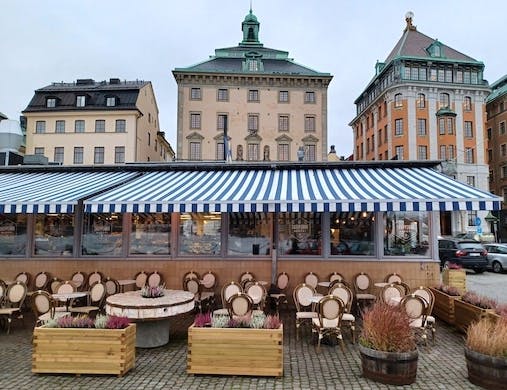BorderLines: Finding the Sweet Spot in Stockholm
The sights and cultural attractions of Stockholm are myriad enough to fill a month or more.

The famous travel writer Paul Theroux has declared he could find almost any place in the world interesting to visit, except maybe Scandinavia. It’s not hard to fathom eschewing the Nordics for, say, the tropics, but telling an ink-stained kvetch like me not to do something just sends my contrarian heart racing.
As it happens, I was shunning borderline-lockdown London, and en route to warmer Euro-climes I chose to stop in Stockholm so I’d be able to decode for myself the mysteries of IKEA and people who seem maddeningly happy despite having only about six hours of daylight — not to be confused with sunshine — this time of year.
I wouldn’t have long to do it, but being on the ground in a foreign city still beats reading about it on Wikipedia. When I arrived in November without a guidebook, I quickly noticed that everybody else was without a mask. Sweden took a controversial, dare I say contrarian, approach to the pandemic last year, refusing to impose the questionably effective lockdowns undertaken by one European country after another. Maybe that’s not a big surprise: After all, despite its membership in the bureaucracy-loving European Union, Sweden holds on to its own currency, the krona, with a kind of cool, principled relish.
Speaking of cool, when I entered my hotel, a dark and posh bolthole called the Six, not one person looked at me askance for being the only one masked up, and the reception desk employees even donned masks in a bid to make me feel more welcome. I’d say it worked.
If it was Mr. Theroux who unwittingly flung me into Stockholm’s frosty charms, my compass for this brief sojourn was actually another writer who dissed Stockholm, the late Jan Morris, who called it a second-tier city. Crossing the narrow Strömbron Bridge over some ravishingly gloomy autumn waters, I wasn’t sure of the accuracy of that assessment because I soon arrived at the heart of Gamla stan, the urban island where Stockholm started in 1252. It’s a compact patchwork of cobblestone streets, fanciful 17th- and 18th-century buildings peppered with medieval remnants, and the pièce de résistance, the Royal Palace that is next door to the Swedish Parliament.
With the exception of those large structures, the facades one passes by are mainly a mix of ochre and gold, which play quite nicely against winter skies. I imagine in summertime the winding lanes like Mårten Trotzigs alley get crowded — it’s scarcely three feet wide at its narrowest point — but I pretty much had this gracious pastel Smurf village to myself as I clasped my scarf under heavy gray skies. It would be best to wait for some proper Swedish sunshine to get the most out of an expedition to some of the islands a bit farther afield — like Vaxholm, with its preserved wooden houses and a fortress, and Fjäderholmarna, featuring fine restaurants and the Mackmyra whisky warehouse. The Stockholm Archipelago includes nearly 30,000 little islands and rocky islets in all, some even with sandy beaches.
The sights and cultural attractions of Stockholm are myriad enough to fill a month or more and I barely had time to stock up on Marabou chocolate and Lakerol mints at the 7-11 I stumbled upon. On the list were Fotografiska, a contemporary photography venue with an outpost in Manhattan; the Nationalmuseum, where 18th-century sculptures of Norse gods Thor, Odin, and Balder still steal the thunder in a recently renovated sculpture courtyard; the Moderna Museet of contemporary art, which also has a rooftop restaurant; the Nobel Prize Museum; and, in the category of off-radar house museums, Hallwylska Museet, a perfectly preserved urban manse that once belonged to a 19th-century Swedish countess but is anything but stodgy. A temporary exhibition that illuminates a more obscure and, for some, poignant slice of Stockholm’s heritage is titled, “Fags: Meeting-places in an Age of Forbiddance.” No, this is not a mistake by Google translate.
What tempted me most of all was the Vasa Museum, which displays the world’s best-preserved 17th-century ship. Funny thing about that fancy 64-gun warship: Although it was much publicized ahead of its launch in 1628, it sank on its maiden voyage after sailing around Stockholm’s harbor for only 10 minutes.
The food scene in Stockholm is burgeoning, with an emphasis on local, Nordic ingredients and an impressive array of vegan and vegetarian options. At the Grand Hotel, Chef Mathias Dahlgren whips up next-gen lacto-ovo-vegetarian eats at his sleek Rutabaga restaurant. At Chef Elvira Lindqvist’s plant-based Oxenstiema, every ingredient is sourced from a “foraging” farm in the Swedish countryside. And then of course there’s the daily fika, or Swedish coffee and cake break. Hail to the emblematic Princess Cake. Its spongy bases are layered with fresh custard and raspberries, doused with whipped cream, and wrapped in green marzipan icing with a pink marzipan rose plunked on top. With a slice of this I may have finally met my Waterloo — or, in the immortal words of ABBA, “How could I ever refuse/I feel like I win when I lose.”
Yes, I ceded self-control and gained a pound or two on account of that sweet Princess, but surely there are worse sins than seduction by Swedish pastry.

